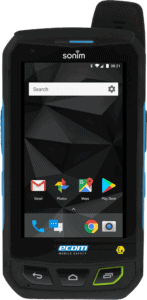Blogs
Staying Connected in Hazardous Areas: Intrinsically Safe Devices
For many field workers in hazardous environments, the key to getting the job done and remaining safe lies in the tools they use to communicate.
Time and again, land mobile radio has proven itself to be a reliable, resilient means of voice communication. For those in hazardous environments, Intrinsically Safe (IS) portable radios enable that communication despite the many challenges associated with these dangerous working conditions.
But there are some cases where portable radios aren’t always the best fit for certain users or jobs. Maybe a task requires use of broadband data, or a specific software application. The solution to maintaining the reliable communications provided by IS radios while offering increased capabilities lies in integrating radio and smartphone systems. In hazardous areas, this integration is possible with Intrinsically Safe smartphones.
Much like IS radios, Intrinsically Safe smartphones – like the Ecom Smart-Ex 01 – are engineered to operate safely in hazardous environments, and meet global IS standards.
Here are some of the ways adding an IS smartphone to your critical communications network can benefit your workers.
Keeping users connected
Integrating Push-To-Talk over Cellular (PTToC) applications – like Tait’s solution – with radio equipment enabl es people to choose the best device for their situation and still communicate with each other. This can significantly extend the capability of any team to utilize the dedicated coverage, reliability and off-network calls that radio provides and bring in smartphone users who are offsite or don’t usually carry a radio.
es people to choose the best device for their situation and still communicate with each other. This can significantly extend the capability of any team to utilize the dedicated coverage, reliability and off-network calls that radio provides and bring in smartphone users who are offsite or don’t usually carry a radio.
Connectivity is enhanced further in conjunction with a mobile platform like Tait UnifiedVehicle. The WiFi to Cellular bridge provided by UnifiedVehicle supports PTToC applications by delivering additional range and increased data speeds to areas where coverage is a challenge.
Enhancing user safety
Along with the enhanced safety that comes with constant, reliable voice communications, IS smartphones and IS radios share a range of built-in features that further support worker safety, such as Man Down, Lone Worker, GPS location tracking and “glove friendly” Push-To-Talk. IS smartphones provide additional safety options including navigation, indoor tracking, access to worker safety applications, and a touch screen that’s usable with dirty or wet work gloves.
Just like Tait Tough IS portable radios (TP9361 for DMR and TP9461 for P25), the robustness of the IS smartphone itself gives workers peace of mind that their communications equipment will withstand their tough working conditions and continue functioning, giving them reliable access to the voice and data features designed to keep them safe. This allows them to stay focused on the task at hand while trusting they can call for help if needed. Rugged and functional features include loud speakers, noise cancellation, powerful batteries, and water and drop resistance.
Increasing worker efficiency
High capacity for applications means you can load smartphones with programs and applications specifically suited to your needs, giving your workers access to productivity-enhancing tools. Since IS smartphones safely operate in hazardous environments, users can remain on site and use these applications via their smartphone, rather than exiting the area to go log records or receive data and information. This saves time, and allows them to work both smarter and safer.
The role of data in critical communications is growing every day, and with it grows the range of applications available. IS smartphones use operating systems that support a wide variety of applications. The Ecom Smart-Ex 01, for example, has Google certification to run over 700,000 software applications. Applications can help with a wide range of efficacy-increasing tasks, including things like route management, scheduling, integrity inspections, condition monitoring, asset management, process automation, and much more.
Many companies have application libraries – like the Ecom App Library – with a large offering to help you realize the full potential of an IS mobile device. Watch the video below for some more examples.















